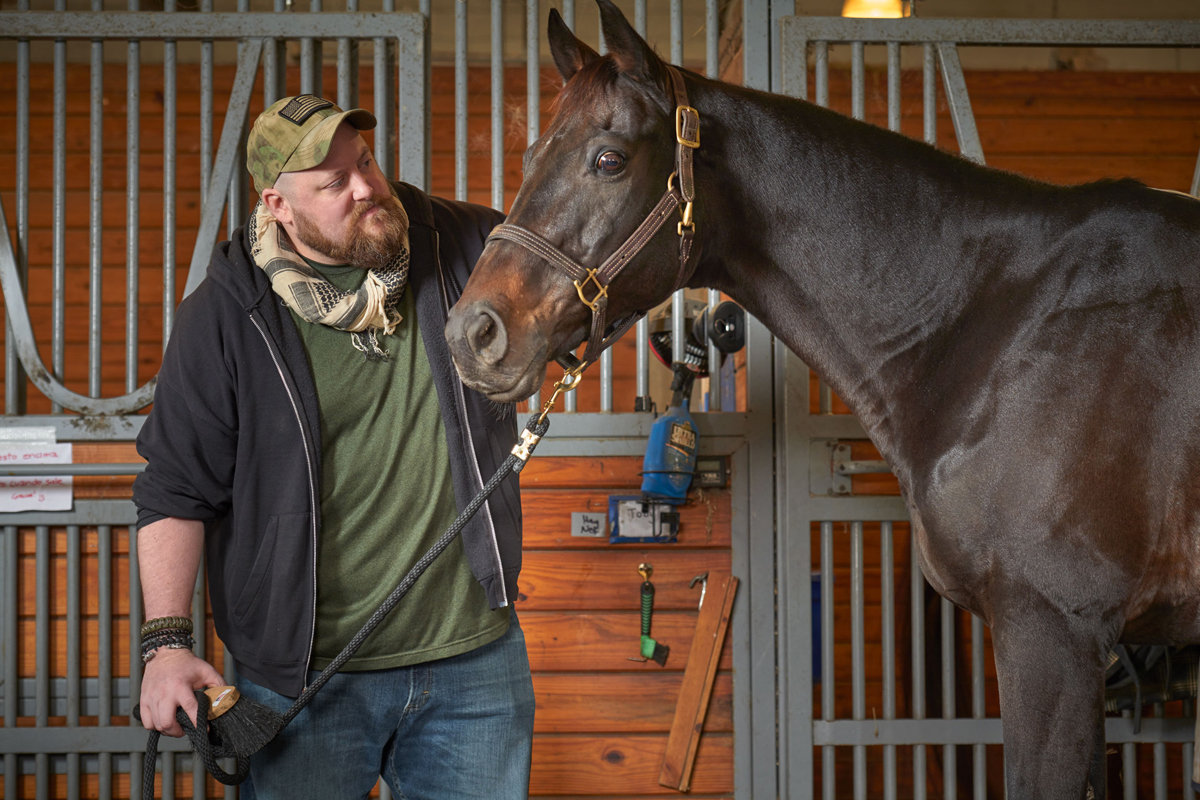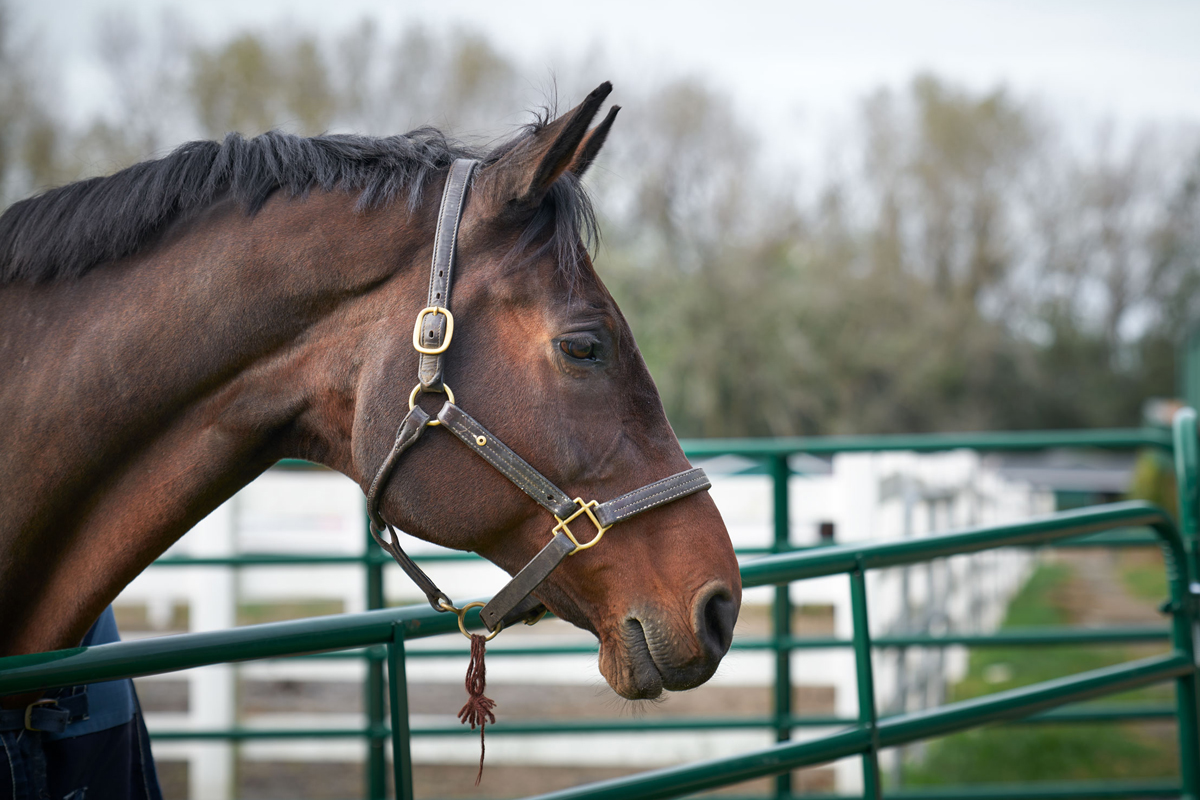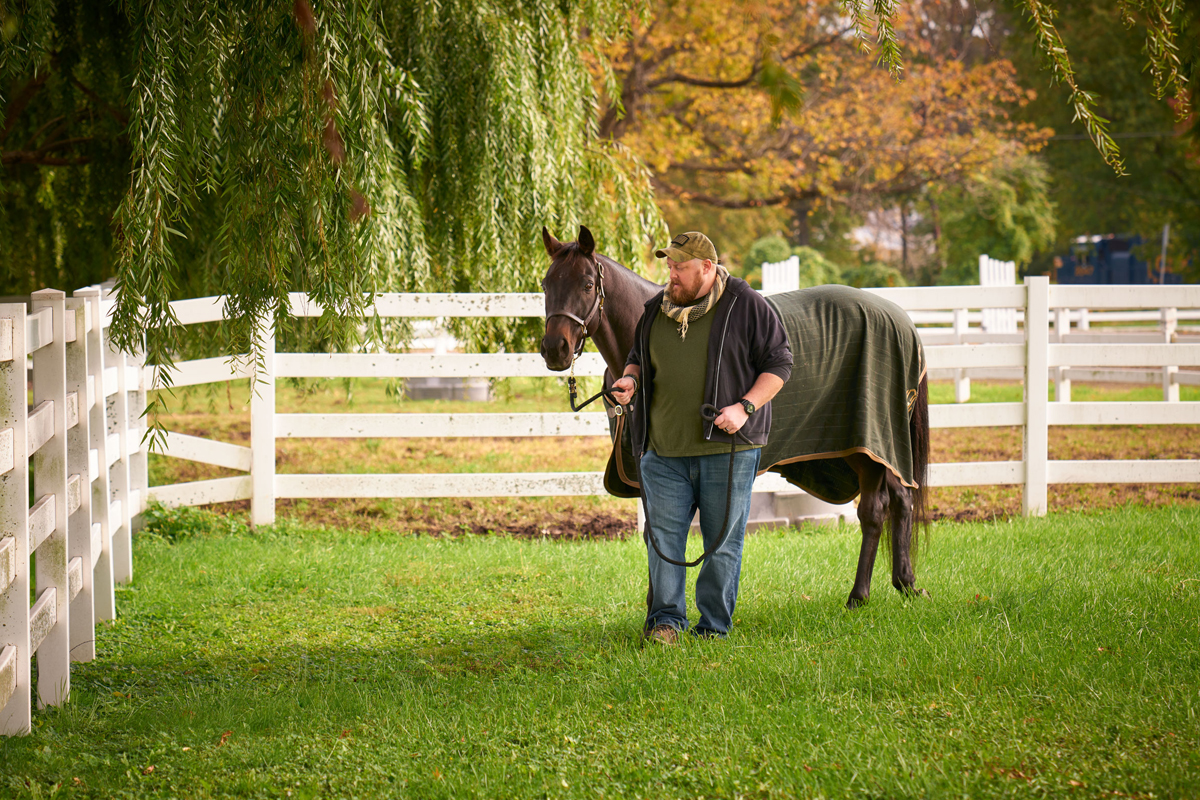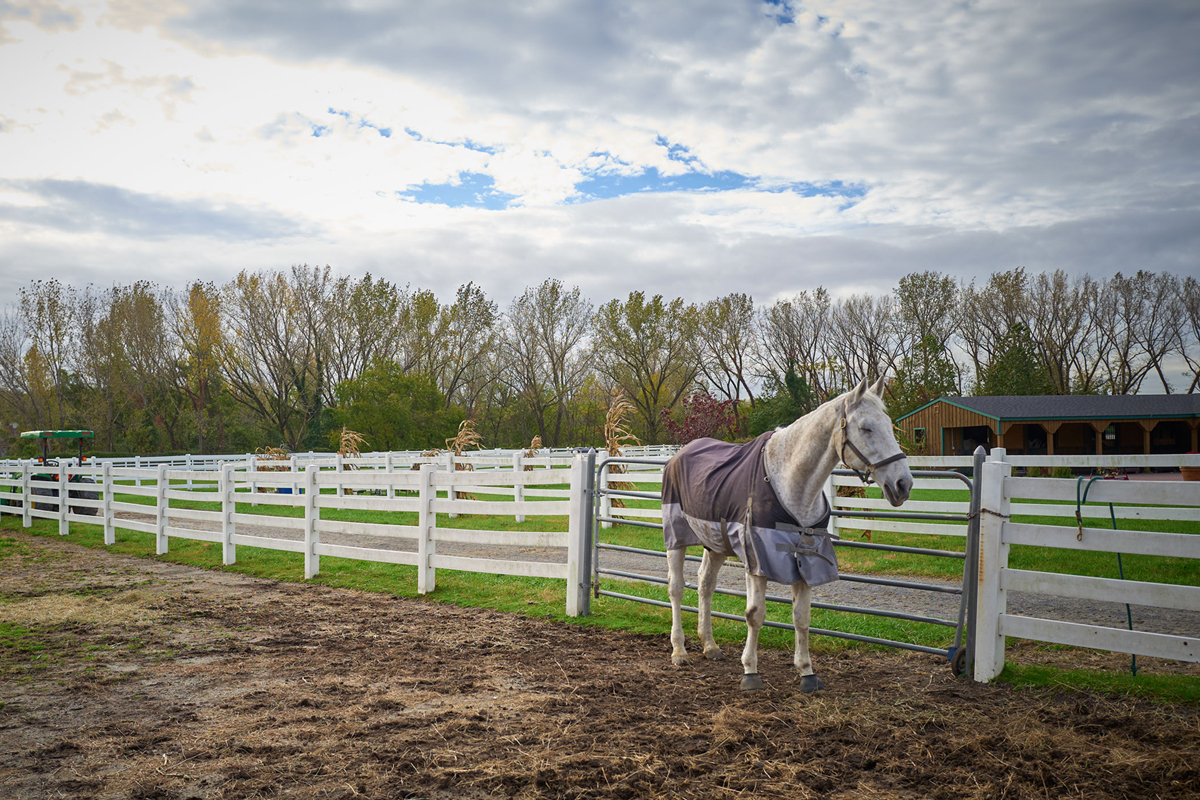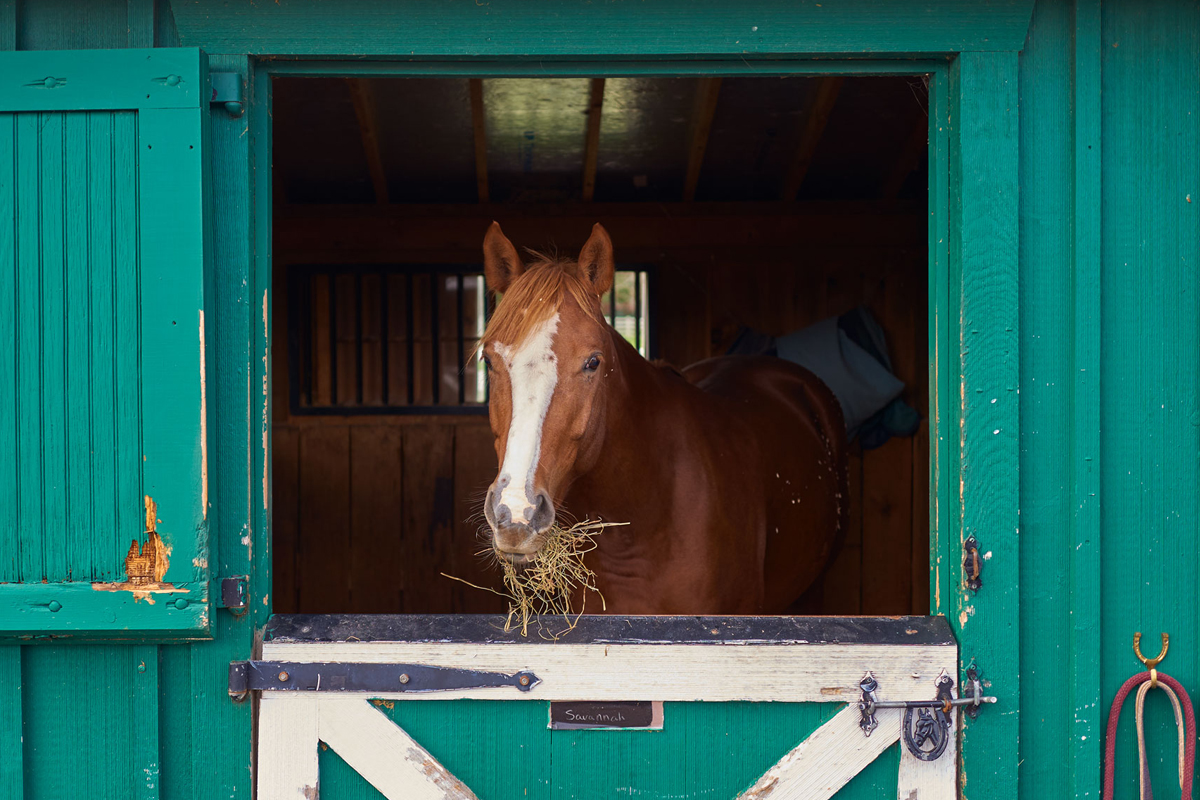Can Horses Help Veterans with PTSD?
A new study shows how equine therapy holds promise as an effective treatment for veterans recovering from trauma.

On a crisp fall morning outside a horse stable in northeastern New Jersey, Matthew Ryba, a Marine Corps veteran of the Iraq and Afghanistan wars, exhales. After spending an hour with Crafty Star, a 13-year-old thoroughbred, Ryba says his mood has already improved.
“It’s nice to have a change of scenery and see the horses, after the past couple of years being mostly confined to our homes and Manhattan [due to COVID-19],” says Ryba, director of community outreach and education at the NewYork-Presbyterian Military Family Wellness Center. “I feel better after time with Crafty.”
Ryba is back at the Bergen Equestrian Center, a 22-acre willow tree-shaded horse farm a few exits from Manhattan, home to a study, known as the Man O’ War Project, that sought to determine the effectiveness of equine therapy in treating veterans with post-traumatic stress disorder (PTSD).
“There are plenty of anecdotes saying that equine therapy works, including vets saying, ‘This saved my life,’ but it hadn’t been well studied,” says Ryba. The Man O’ War Project was the first university-led research study to examine the benefits of equine therapy scientifically and develop a protocol for it. The results, a culmination of more than three years of research, were published recently in the Journal of Clinical Psychiatry.
Ryba, an author of the study, helps build relationships with the veteran community as part of his work in the lab of principal investigator Dr. Yuval Neria, co-director of the NewYork-Presbyterian Military Family Wellness Center. Dr. Neria, a decorated veteran of the Israeli army, developed and tested the PTSD equine therapy program with his co-principal investigator, Dr. Prudence Fisher, a research scientist at New York State Psychiatric Institute.
A drive to help veterans
The team is focused on finding new, innovative ways to help veterans who are struggling with PTSD, a disabling condition that affects somewhere between 11% and 20% of veterans of recent U.S. wars, according to the U.S. Department of Veterans Affairs.
“I was curious to learn how we can use animals in general, and horses in particular to help veterans with PTSD,” says Dr. Neria, who is also director of the PTSD Treatment and Research Program at Columbia Psychiatry and the New York State Psychiatric Institute. “Veterans can be pretty critical of what the medical community can offer them. We need to be creative to help this population. They deserve it.”
The paper notes that many veterans avoid treatment due to mistrust, stigma, and concerns about the treatment experience. The treatment considered most effective for PTSD is exposure therapy, which exposes patients to their fears in a safe space, helping them to face their fears and heal. Unfortunately, many people, and veterans in particular, are reluctant to try it.
“Vets say, ‘Don’t make me relive the trauma that I’m trying to avoid,’” says Ryba. “But they are open to trying new things.”
If I’m not helping this population, then I am not doing the right kind of work.
Matthew Ryba
For those with PTSD, traumatic memories cause nightmares, intrusive thoughts, flashbacks, irritability, difficulty sleeping, hypervigilance, and more.
“Horses are big, frightening and overwhelming sometimes,” says Dr. Neria, who also serves as professor of clinical medical psychology at Columbia University Vagelos College of Physicians and Surgeons. “They are prey animals, constantly attempting to figure what is safe and what is a threat around them, which makes them hypervigilant and always on alert. I thought, ‘What a perfect opportunity’ for traumatized veterans who suffer from a fear-related disorder, such as PTSD, to interact with these majestic animals whose behaviors really resemble PTSD symptoms.”
Since there had never before been a large-scale study on equine therapy, part of the researchers’ challenge, outside of testing the treatment, was to standardize and create a manual for it, so that others could teach and benefit from it.
“Usually you develop a study based on existing knowledge,” says Dr. Neria. “Here, there was almost nothing. There was anecdotal information out there, that horses can be great healers, but how do you make a treatment out of it?”
Creating a playbook for equine therapy
From 2016 to 2019, the team conducted a large, open trial, recruiting 63 military veterans with a confirmed PTSD diagnosis. Mental health professionals evaluated the participants, who also got brain-imaging scans before and after the equine therapy. In the summer of 2019, the veterans traveled by bus over the George Washington Bridge to the equestrian center (just about 10 minutes from the NewYork-Presbyterian/Columbia University Irving Medical Center campus) for eight 90-minute weekly group sessions that involved grooming the horses, leading them, and participating in trust-building exercises.
“They might lead the animals without a rope into all sorts of obstacles and challenging problems,” says Dr. Neria. “It’s really about overcoming insecurity, anxiety, and fear, and being able to make the animal really comfortable with them, and for them to be comfortable with the animal.”
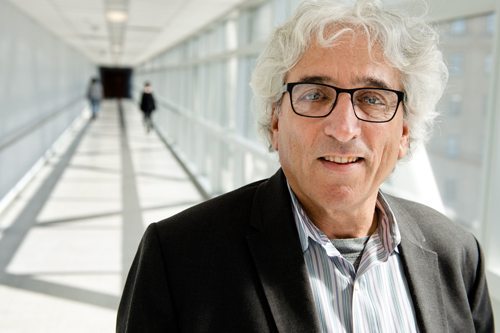
Dr. Yuval Neria
An equine expert supervised each session for safety and to explain what the horses might be feeling, and a mental health counselor helped the veterans understand their reactions to the horses and “develop better skills to deal with stress, tension, and fear,” says Dr. Neria.
“Horses almost mirror the emotions of the human that they are with,” explains Ryba. “So if you walk up to a horse and you’re scared to touch them and show all this fear, they sense that and react with a fear response. Seeing your own fear mirrored in another animal helps you make connections with what’s going on inside you, and make internal adjustments like, ‘If I calm down, the animal will calm down.’”
Importantly, the veterans did not have to discuss or re-live their trauma during the therapy.
“They don’t talk about their military experience in a direct way,” says Dr. Neria. “There is comfort in an experience that takes their attention from what happened to them before, and what they are feeling inside, to what is going on outside: nature, horses, and animals. They are able to get a break and to develop new experiences.”
Examining the results
Still, the researchers were skeptical about what kind of concrete evidence they would find for equine therapy as a treatment for trauma.
Ryba, who acts as a liaison with the veteran community, recalls his own skepticism. “You mean we’re going to brush horses for a couple of weeks and our trauma is going to go away?” he joked when he first heard the idea.
The results surprised them: More than half of the patients recovered from PTSD and three months later continued to show improvement. Dr. Neria shares that overall, the veterans reported fewer feelings of depression, distance from others, inability to sleep, anger, and suicidal thoughts. They also reported less hypervigilance, nightmares, and feelings of needing to be alert and on guard.
“We were very pleased to see such a dramatic change in what they reported to us,” says Dr. Neria.
Changes appeared in the brain, too. “When we looked at the brain scans and compared post-treatment scans to pre-treatment scans, I was even more surprised to find both structural and functional changes in the brain, particularly in the areas where some of our capacity to seek and enjoy pleasurable experience is located,” says Dr. Neria. “That’s a very interesting finding.”
Dropout rates of the trial were low, which is also unique. “It was the first time we had people who wanted to stay and continue the treatment,” says Ryba. A few veterans continue to visit the center to work with the horses.
The team is piloting a study for adolescents with anxiety at the center, and preparing for a larger, full-scale randomized control trial to study equine therapy for PTSD further.
While the researchers are not sure exactly why the therapy helps so much, they have a few theories: the peaceful environment away from the city, the group exercises, and the mirroring of emotion between the horses and humans.
“Overcoming a sense of fear and anxiety, and being able to bond and feel safe with the animal — that’s part of the process that was key to their healing,” says Dr. Neria. Horses have also served with military for thousands of years, both Dr. Neria and Ryba point out.
Ryba says as a veteran, he can relate to a retired racehorse like Crafty, who he thinks of as having had a high-intensity, fast-paced job before serving as a therapy horse. “You feel a little bit lost when it’s behind you,” he says. “We can understand that.”
For Ryba, part of his purpose now is to help others. He has dealt with survivor’s guilt after losing 38 fellow service members during the time he served and another 10 to suicide once they returned home. He says, “If I’m not helping this population, then I am not doing the right kind of work.”
He was encouraged that many of the participants decided to try talk or exposure therapy after completing the equine therapy, and believes that PTSD is curable. “It’s not a scarlet letter, and you can do things to overcome the diagnosis,” he says. “It can get better.”
Learn more about the NewYork-Presbyterian Military Family Wellness Center. Visit the Man O’ War Project for more information about the study.

